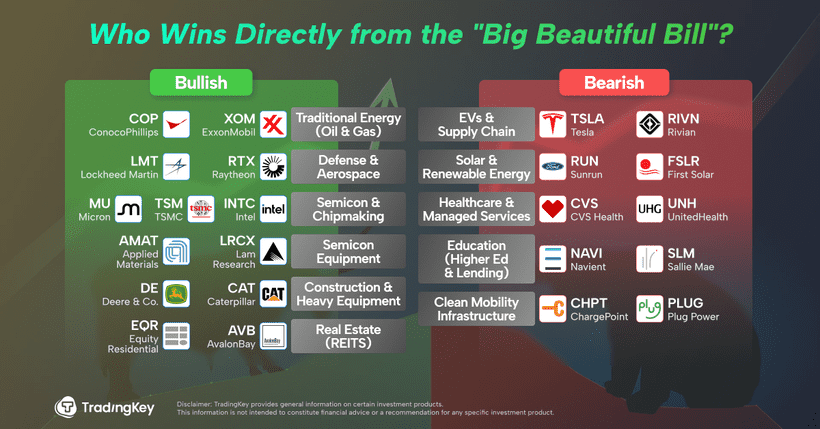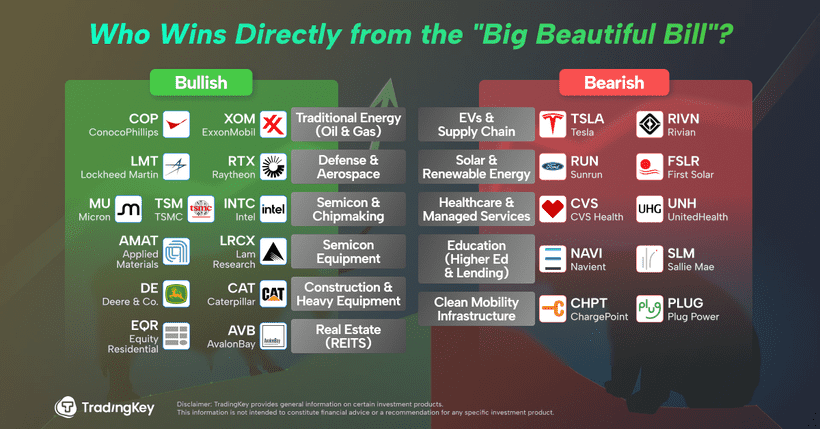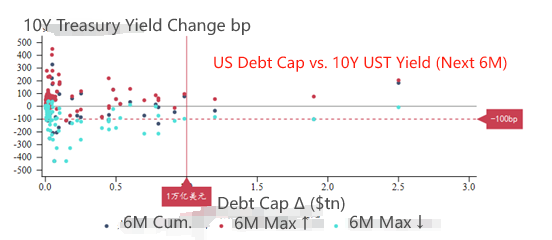Who Wins Directly from the "Big Beautiful Bill"?


TradingKey - Last Friday, U.S. Congress passed what Donald Trump proudly calls the “Big Beautiful Bill.” The legislation has already given U.S. markets a short-term lift—by unlocking new liquidity and opening the door to valuation re-rating in select sectors. Expect winners in energy, defense, and manufacturing. ExxonMobil (XOM), Lockheed Martin (LMT), and Intel (INTC) all rallied after the bill passed.
The “Big Beautiful Bill” is more than just fiscal policy—it’s a political statement. It checks multiple boxes on Trump’s “America First” agenda: bring back manufacturing jobs, secure domestic supply chains, and shift U.S. economic leadership back toward strategic and industrial sectors.
Massive tax cuts for companies and high-income earners are intended to boost corporate profits and consumer spending. Industries tied to oil, gas, and defense are getting generous support—whether through deregulation or direct fiscal backing. In short, Trump wants to re-anchor U.S. strength to what he sees as “real” industries: energy, weapons, chips, and hard infrastructure.
Politically, this is also his first signature legislative win since returning to D.C. It helps solidify his position within the Republican Party—and sends a clear message to his base that he’s delivering on campaign promises.
Key Provisions of the Trump Tax Cuts | ||
Tax Provision | Current Law Limit | Big Beautiful Bill Final Version (2025-2028) |
Standard Deduction | $15,000 (Single), $30,000 (Married) | $15,750 (Single), $31,500 (Married) |
Senior "Bonus" Deduction | $1,600 (65+ single/unmarried), $2,000 (married) | $7,600 (65+ single/unmarried), $2,800 (married) |
State and Local Tax (SALT) Deduction | $10,000 | $40,000 in 2025, then +1% annually until 2029, revert to $10,000 in 2030 |
Child Tax Credit | $2,000 per child, refundable up to $1,700 | Unchanged |
Estate and Gift Tax Exemption | $13.99 million (Single), $27.98 million (Married) | $15 million (Single), $30 million (Married) |
Tip Income Deduction | None | Up to $25,000, effective 2025-2028 |
Overtime Income Deduction | None | Up to $12,500, effective 2025-2028 |
Auto Loan Interest Deduction | None | Up to $10,000, effective 2025-2028 |
"Trump Account" Savings for Children | None | Up to $1,000 per child, effective 2025-2028 |
Other Welfare-Related Deductions | Cancelled after 2021 | $1,000 (Single), $2,000 (Married) |
Follow the Money: Where the Bill Allocates Resources
Over the next 10 years, the bill commits $288 billion in new defense and border security spending. It covers everything from missile defense systems to nuclear stockpile modernization, shipbuilding, and upgrading border infrastructure. This should directly benefit defense contractors like Lockheed Martin (LMT) and RTX, giving them stronger order visibility going forward.

Traditional energy also wins big. The bill ends federal support for solar and wind, instead loosening regulations for oil, gas, and coal producers. For example, it cuts royalty payments for drilling on federal land—reducing operating costs for firms like ExxonMobil (XOM) and ConocoPhillips (COP). It also delays penalties tied to methane emissions, easing compliance pressures in the sector.
However, tax credits for solar and wind are being phased out, meaning companies like First Solar (FSLR) and Sunrun (RUN) may face weaker demand. EV makers like Tesla (TSLA) and Rivian (RIVN) are also affected as federal purchase subsidies are removed—reducing incentives for consumers and adding pressure to EV sales and margins.
On the manufacturing side, the bill reinforces industrial policy with continued tax incentives for advanced manufacturing—specifically semiconductors. Intel (INTC), Micron (MU), and TSMC are among the names that could benefit as they ramp up U.S.-based capacity and tech upgrades.
The U.S. Dollar Remains Under Pressure
The bill’s tax cuts and spending hikes are bringing fiscal expansion back into focus—and that has implications for both gold and the dollar.
For gold, the logic is straightforward: rising deficits and weaker fiscal discipline make gold a more compelling macro hedge. Historical patterns show that in years when U.S. deficits grow sharply, gold tends to outperform. While recent technicals suggest short-term consolidation, downside looks limited, and the longer-term trend remains positive.
As for the dollar, near-term strength has returned on the back of stronger data and softer rate-cut bets. But further out, concerns around U.S. debt sustainability and de-dollarization could weigh on sentiment. The massive borrowing required to fund this bill—and future ones like it—may undermine longer-term dollar credibility, especially among foreign investors.
The Catch: Fiscal Risks and Social Pushback
In the short term, the Big Beautiful Bill delivers marginal economic benefits through large-scale tax cuts and increased fiscal spending. However, this stimulus comes at the cost of a ballooning fiscal deficit and swelling public debt, raising long-term inflationary risks. While current inflation remains subdued and economic fundamentals appear sound, the long-run fiscal pressure is alarming.
According to a recent report by Bank of America's Michael Hartnett warning that U.S. federal government debt could surpass $50 trillion within seven years.
Deficits and debt are two sides of the same coin: persistent fiscal deficits must be financed through borrowing, which in turn leads to higher government debt. Yet rising debt levels make future deficit reduction increasingly difficult. To sustain mounting deficits, the government will need to increase the supply of Treasury bonds, placing upward pressure on interest rates. This crowds out private investment and dampens long-term economic growth. The most pessimistic forecast comes from economists at Yale University, who suggest that the Big Beautiful Bill could significantly weaken the U.S. economy’s long-run growth potential.
Historically, when the debt ceiling is raised by more than 1 trillion in a single move, Treasury yields tend to trend higher over the following six months. This time, with the statutory federal debt limit raised by 5 trillion, the upward pressure on yields is likely to be substantial. The U.S. 10-year Treasury yield could once again approach the 5% level in Q3.

Further compounding the pressure is the potential return of aggressive tariff policies following July 9. The U.S. is expected to impose steep tariffs on imports from multiple countries to protect domestic manufacturing and jobs. While politically popular, these protectionist measures raise import costs and squeeze profit margins for export-oriented manufacturers and supply chain operators. Industries heavily reliant on imported components and raw materials—such as technology, electronics, and automotive—are likely to bear the brunt.
Moreover, tariffs push up the prices of consumer goods, which disproportionately affects middle- and low-income households, undermining their purchasing power and exacerbating concerns over economic inequality.
Taken together, the Big Beautiful Bill and the renewed threat of tariffs represent a twin challenge for U.S. economic policy. On one hand, tax cuts and fiscal expansion aim to stimulate growth. On the other, soaring deficits, weakened social safety nets, and a resurgence of trade protectionism risk increasing costs across the supply chain and amplifying structural imbalances.
This has also sparked criticism of what many are calling a “reverse wealth transfer” — benefiting the rich at the expense of the poor. The reason: the tax cuts heavily favor corporations and high-income groups, while the corresponding spending cuts disproportionately affect low-income and vulnerable populations.
The most contentious element of the Big Beautiful Bill is, without doubt, its sweeping cuts to Medicaid. Over the next ten years, the program will face nearly $1 trillion in funding reductions. At the same time, a new work requirement will be introduced — adults aged 19 to 64 must work at least 80 hours per month to remain eligible for benefits.
With the signing of this bill, the decades-long expansion of Medicaid in the U.S. comes to an end. It also rolls back premium subsidies under the Affordable Care Act (ACA), weakening the broader safety net for healthcare coverage.
According to estimates from the Congressional Budget Office (CBO), these changes could lead to 11.8 million Americans losing health insurance by 2034, effectively undoing much of the coverage gains achieved under Obamacare.
The bill comes at a time when the U.S. is approaching a critical 2025 debt ceiling deadline, grappling with growing fiscal deficits, and facing increasingly severe social polarization. And while inflation data appears relatively stable at the moment, the combined pressure of rising debt, social inequality, and reduced safety nets warrants close ongoing attention.







